[imagebrowser id=211]
This photo gallery is excerpted from the Gun Digest Book of the Revolver.
My Recommended Revolver Resources
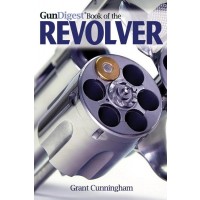 Gun Digest Book of the Revolver
Gun Digest Book of the Revolver
Gunsmithing Pistols & Revolvers
[imagebrowser id=211]
This photo gallery is excerpted from the Gun Digest Book of the Revolver.
My Recommended Revolver Resources
 Gun Digest Book of the Revolver
Gun Digest Book of the Revolver
Gunsmithing Pistols & Revolvers
The concept of Boomershoot is simple. First, you shoot a target. Then the target explodes.
From 3-gun competitions to zombie-themed shoots, there's no doubt the popularity of firearms events is on the rise. While some are more competitive than others, Boomershoot in north central Idaho stands out as a strictly social shooting event.
“It's not a competition. People just shoot for fun,” said Joe Huffman, Boomershoot director, in a phone interview.
As Boomershoot's founder, Huffman said fun was the mission from the beginning. He attended a dynamite shoot in Blanchard, Idaho, in 1996. Not wanting to wait another year, Huffman said he used his farming background to mix his own explosives.
In October 1998, Huffman invited members of the Microsoft Gun Club and some locals for an explosives shoot. Boomershoot officially opened as a public event the following spring.
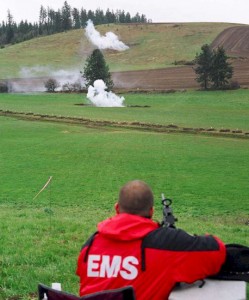
After an ceremonious opening fireball, Boomershoot runs two portions of shooting.
The high-intensity half has shooters at close-range hitting multiple explosive targets. The other half involves long-range targets set up to 700 yards away.
Ammunition that can maintain at least 1,700 feet per second of velocity at 375 yards and beyond is recommended. That's because the explosive targets aren't all that sensitive.
“It takes a pretty hard hit to detonate,” Huffman said.
The most common firearm used is the .308, according to the Boomershoot website.
There aren't official scores to keep, but there is plenty of good-natured rivalry. Shooters occasionally “poach” each others' targets, Huffman said. It's all in good fun, though.
In keeping with the spirit of the event, Boomershoot sometimes pegs special targets for destruction. A toilet was exploded one year in honor of Dave Barry. The humorist has a notorious dislike of low-flow toilets. Although Barry could not attend the event, Boomershoot organizers still sent him a piece of shattered porcelain.
Pieces of flying debris are serious safety concerns. Huffman said Boomershoot organizers clear the area around the explosives before the event. Shooters are far enough away that they aren't threatened by the explosions themselves.
Also keeping shooters safe is the organizers' knowledge of explosives.
“I have a really good crew of about 15 people or so with permission from [Bureau of Alcohol, Tobacco, Firearms and Explosives] to handle explosives,” Huffman said.
Having many shooters in one place at one time is another concern.
“The explosions aren't a threat from 375+ yards away, but the guns are. Eye and ear protection is highly recommended,” the Boomershoot website states in its What to Bring section.
Huffman said spots fill quickly for Boomershoot each year, but there are still some available for 2013. The event will take place April 28, with a rifle clinic the two days prior. Click here for more information.
 Three-gun competitions are another type of shooting event enjoyed by many firearms enthusiasts. Dive into this exciting sport with the Complete Guide to 3-Gun Competitions book.
Three-gun competitions are another type of shooting event enjoyed by many firearms enthusiasts. Dive into this exciting sport with the Complete Guide to 3-Gun Competitions book.
Click here to order this essential 3-gun book from GunDigestStore.com.

Editor's Note: This article is an excerpt from the Complete Guide to 3-Gun Competition book, available now at GunDigestStore.com.
The sport of 3-gun competition falls within the discipline known as “action shooting,” which really is a politically correct term for practical shooting, the sport based on the quest for a higher level of combat shooting. While action shooting has been formally presented in America now for several decades, it has taken various shapes.
Today, action shooting has many forms, most of which traces itself back to the formation of the International Practical Shooting Confederation, or IPSC. Later, the United States Practical Shooting Association was formed as the U.S. domain of IPSC, as IPSC is truly international and branches into many countries around the world. The USPSA remains the strongest region, boasting more than 20,000 members nationwide.
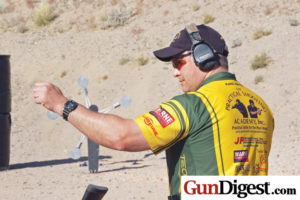
The International Defensive Pistol Association (IDPA) is an offshoot of IPSC-style shooting, formed by shooters unsatisfied with the “gamesmanship” perceived to be prevalent within USPSA matches and rules. IDPA currently claims more than 19,000 members, and its competitions differ from IPSC’s primarily in their rules structure, which establish competitions leaning more towards self-defense or tactical-style shooting, rather than a test of pure shooting skills, as some view the matches of IPSC.
Both USPSA/IPSC and IDPA have been extremely successful in the U.S., but primarily as organizations that promote and sanction pistol competition. Three-gun competition, while influenced by USPSA rules already in place, has developed outside the vacuum of any one governing body, although 3-Gun Nation is quickly becoming the entity that bridges many matches and clubs together.
An event, or match, is a collection of individual courses of fire, commonly called “stages.” During each stage of multiple targets, a competitor, under the direction of a range officer, negotiates that stage—and keep in mind this is an action sport, so there’s lots of moving around from place to place, from one bank of targets to another, and so on—engaging each target as described during the stage briefing given by the range officer before the timer buzzer goes off.
That briefing varies in its instructions, ranging from strictly regimented courses that must be shot in a specific sequence, to free-form design, where the competitor is free to map their own strategy. A stage can have a specific starting area as limited as a small “starting box,” outlined by wood or metal staked into the ground. Stages can also have specific shooting areas, where certain targets must be engaged using particular firearms. Fault lines are also sometimes present, marking the end of the area of movement for a competitor—no shots may be fired outside of a shooting area or forward of a fault line without receiving penalty, which is applied to a shooter’s score in extra time.
After the stage briefing, the squad—a designated number of competitors that rotate through the match shooting each of the stages as a unit—is allowed a walk through period. Often limited to five minutes, competitors get a chance to see each target, walk the stage as they anticipate they’ll run it when it’s their time to shoot—this might include planning out where best to reload, how to approach and shoot over, under, or around a barricade, etc.—and ask any questions of the range officer.
It’s here that a 3-gun competition stage can get a bit complicated and even confusing. At a given match, there are numerous types of targets one might encounter. There are multiple sizes and types of paper targets, with the IPSC-style cardboard torso/head target the most common. (3-Gun Nation recently developed a new bull’s-eye-type paper target that will likely become more common in local club matches.)
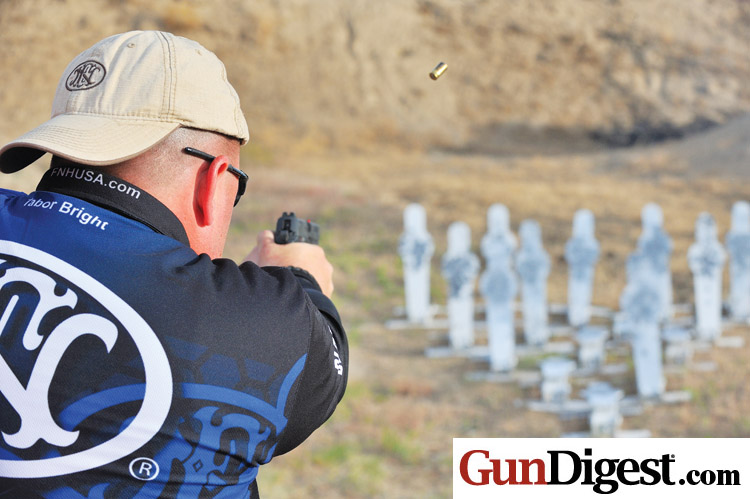
Steel targets also show up in various forms, ranging from simple knock-over pieces of circular or rectangular steel sitting on top of a target stand, to advanced steel target systems manufactured by MGM Targets and others. Hinged “poppers,” also known as “plate racks” (six or more pieces of circular steel affixed to a target stand), static steel plates affixed to target stands, and reactive steel targets that move when struck are all used.
Auto poppers are popular for rifle stages—here, the popper goes down when hit, then mechanically resets itself without anyone having to go downrange. Most reactive steel targets require a range officer to call “hits” when used in competition. Clay birds are another common target, and they’re usually found in the form of a static target placed on a target stand. Clays are also thrown, as they might be in traditional sporting clays, trap, or skeet clay bird games, on some stages, adding a further degree of difficulty to 3-gun competition.

Moving targets offer yet another challenge. Often activated when a popper is knocked down, these limited-exposure targets come in many forms. Usually a paper target, the presentation can be moving from side-to-side, often only partially exposed. It can also turn towards the competitor, and then away again after a moment. There is also an “attack target” which accelerates toward the competitor before disappearing out of view. Limited-exposure targets can be extremely challenging!
Finally, there are the specialty targets—Texas Stars, Spinners, the Propeller Rack—that use gravity and balance to move in various directions. There are many specialty targets, especially the popular ones from MGM Targets, that provide fun and challenging shooting in 3-gun competition.
Ultimately, depending upon the stage description given by the range officer, all of these different types of targets and presentations can be presented for specific or multiple firearms within a given stage—that means 3-gun competition is a thinking man’s game as much as it is one of pure shooting fundamentals and skill.
As with most action shooting sports, 3-gun competition is one that is measured in time. When shooting a stage, the competitor, under the direction of the range officer, will “stage” any firearms (i.e., put them in various places throughout the stage for pickup and use when they get to that portion), and, finally, receive the command to “make ready,” with a specific firearm.
Then, holding a timer that tracks each audible shot, the range officer pushes the timer’s button, a “beep” goes off, and competitor’s rip through stages as fast as their skills allow. At the end of the stage, the raw time it took the shooter to complete the stage is recorded, then any penalties for procedurals or targets missed are applied to form a final stage time, or score. Each stage time is added up, and, as it is with golf, where the fewest strokes win a match, the 3-gun competitor who finishes an event the quickest, penalties included, is the match winner.
Matches themselves vary in size (both competitor number and venue), and form. Major Matches, such as Superstition Mountain Mystery 3-Gun competition, in Arizona, which I’ll cover later in this book, feature 250 or more shooters, utilize a wide array of props and targets, and boast some of the fastest, wide-open types of stages in 3-gun competition. They often consist of short stages confined to three-wall bermed shooting bays, and the targets and scoring system combine to promote extremely fast shooting.
Blue Ridge Mountain 3-gun, conversely, is a Major Match situated in the rolling hills of Kentucky, which provides a tremendously challenging natural terrain course of fire, one that is also very physical. The scoring and target placement penalize inaccuracy, especially with a rifle, so Blue Ridge becomes a very physical, accuracy-oriented test of skills.
At the local level, match stages are most often contained in shooting bays and limited to 100 yards, although some clubs certainly have the ability to hold long-range rifle stages. Fields of competitors can be anywhere between 20 and 100 in a one-day local club match, offering a wide range of shooting experiences. No matter what the size or location of the shoot, scoring formulas, rule structures, target presentations, and match styles can vary wildly in the sport—there is, quite literally, a different face to 3-gun competition nearly everywhere you go. But, this is part of its core, and just one of the many reasons 3-gun competition remains the most exciting discipline in all of shooting.
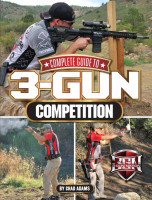 This article is actually the first chapter from the hit book, Complete Guide to 3-Gun Competitions. It's full of in-depth information on 3-gun competitions. The book is perfect for anyone looking to get into this exciting sport or competitors looking to up their game.
This article is actually the first chapter from the hit book, Complete Guide to 3-Gun Competitions. It's full of in-depth information on 3-gun competitions. The book is perfect for anyone looking to get into this exciting sport or competitors looking to up their game.
Click here to order the Complete Guide to 3-Gun Competitions book from GunDigestStore.com.

The Civilian Marksmanship Program develops and promotes shooting games featuring the US arms of WWI and WWII. The latest CMP game is the Vintage Sniper Rifle competition. Two-man teams compete in this rifle event; a shooter and a spotter who work together putting rounds on target at 300 and 600 yards.
Each team member fires 10 rounds at a target exposed for only 20 seconds per shot. When the shooter completes his 10 rounds, he switches places with the spotter. Now the next 10 rounds are fired within the time constraints, and finally the stage of fire is finished.
Then the teams pick up their gear and move to the final distance and repeat the routine. A total of 40 rounds for record are tallied and the event results determined.
And this is where the new Leatherwood Malcolm USMC 8X sniper scope comes in.
Introduced at the 2012 SHOT Show in Las Vegas, the Leatherwood/Hi-Lux Wm. Malcolm 8X USMC sniper scope is the newest ‘old' scope on the market, and joins three other externally-adjusted rifle scopes in the vintage Wm. Malcolm line of sniper scopes. This latest model is actually more of a recreation of the 1940 WWII-era Unertl 1 1/4-inch Combination Target Scope, now nitrogen-filled and with modern multi-coated optics, than a replica of a particular Wm. Malcolm sniper scope. The Marines used the 8X Unertl in the Pacific during WWII, and later in both Korea and Vietnam.
This new Leatherwood sniper scope, approved by the CMP, is marked with the Malcolm name over the USMC-Sniper designation, and carries an individual serial number, as did the original USMC sniper scopes. When installed on a rifle with the optimum center-to-center mount spacing of 7.2 inches, the windage and elevation adjustment mechanisms deliver 1/4th-inch impact shifts at 100 yards.
The sniper scope I received for review was an early production specimen (#171) that had recently done tradeshow exhibit duty at the St. Louis NRA Show. The sniper scope had the recoil spring installed, verboten under the CMP sniper match equipment rules. Corbett Leatherwood tells me the sniper scopes are currently shipped with the recoil spring uninstalled, but in the box — perfect for the high-power rifleman and CMP competitor. However, down the road they may offer the sniper scope both ways — with and without the recoil spring installed.
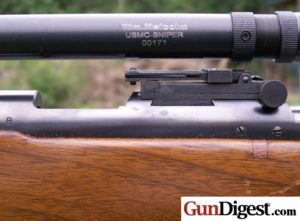
Carefully read the instructions so you understand how the sniper scope works, and why. In the box you'll find a larger L-shaped tool with a Torx bit on one end that fits the rear mount's adjustment turret locking screw — a very important item. Be sure to loosen the locking screw before you start cranking on the W&E adjustment knobs.
In the heyday of the externally-adjusted rifle telescope, high-power shooters generally did not use the recoil spring. They wanted the sniper scope to slide away from them as the rifle recoiled, which not only reduced the chances of a nice crescent-shaped divot in their brow, but also reduced battering on the sniper scope's innards that occurred when a tensioned recoil spring snapped the tube back into battery.
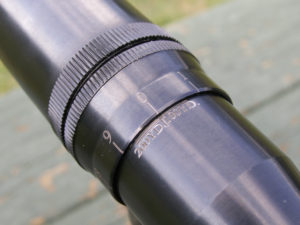
Besides, the recoil spring was not always reliable in fully returning the sniper scope tube to battery, so after each shot, the experienced shooter learned to reach up and giving the tube a gentle tug to the rear to properly seat the sniper scope tube. It's historically accurate and functionally appropriate that the CMP sniper match rules prohibit the recoil spring.
I installed the sniper scope on my old Winchester 52B target rifle fitted with factory-installed blocks 7. 2 inches apart.
Attaching the sniper scope to the mounting blocks is easy. Both the front and rear mounts are free to slide some distance along the 3/4-inch scope tube, so mating the mounts to the blocks is an easy task. Once installed on the blocks, the next step is to adjust the sniper scope for proper eye relief.
The factory specs say you have a little over three inches of eye relief, and I'd use as much of that as possible, especially if you plan to shoot the CMP sniper match, which can be fired off sandbags or from a tight-sling prone position. The Model 1903 is not a heavy rifle, and will bounce around some…especially if the shooter does not have a good cheek-weld and the butt tucked firmly into his shoulder.
The sniper scope's instructions suggest you start at 25 yards and work your way out. Because I was using my Model 52B in 22 LR as the sniper scope test vehicle, I did neither. It's much more fun to set up at 100 yards and blaze away at the pine cones and grass tufts on the backstop berm.
Since the sniper scope is intended for the CMP's sniper match using a rifle chambered for the 30-06 cartridge, let's run through a quick sight-in discussion, using exterior ballistic data for the Hornady Garand A-MAX 168 gr. 30-06 loading from the Hornady Ballistics Calculator program available on its web site, free of charge.
The CMP sniper match is fired at 300 and 600 yards, so we'll start with a point of aim/point of impact X-ring zero at 300 yards. At 300 yards, each quarter-minute click of adjustment moves the POI 0.750-inch, according to the table found in the instructions for my old Lyman Super Targetspot.
According to the Hornady tables, a 300-yard zero puts the A-MAX 168-gr. bullet about 67 inches below POA at 600 yards. At 600 yards each quarter-minute click moves the POI 1.5 inches, so some 45 clicks of elevation are needed to get into the black at 600. Not a problem, since the sniper scope has an elevation adjustment capability of over 125 MOA, according to Leatherwood.
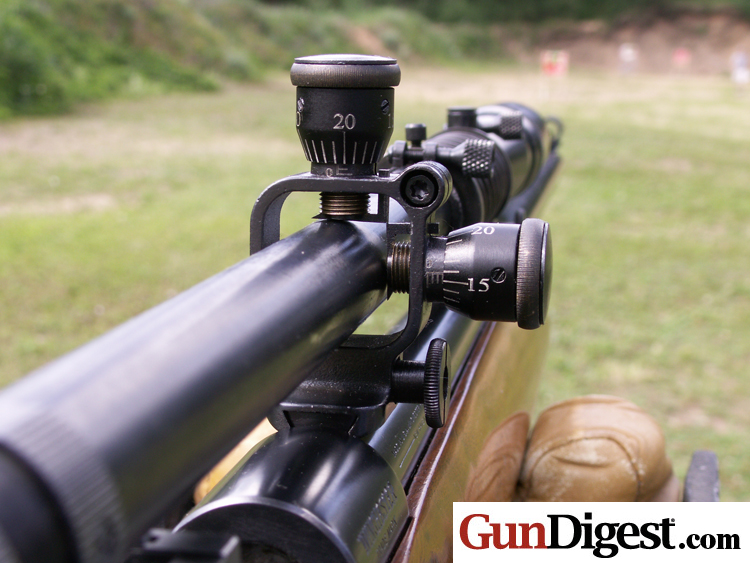
All firing was done off the bench using my Winchester Model 52-B rifle and Winchester's 40-gr. round nose T-22 target ammunition, with targets set at 100 yards. I waited for relatively calm days to minimize wind effect on the light bullet's performance.

Once dialed in to hit POA, the sniper scope proved a reliable performer over the course of a half-dozen trips to the range and a variety of W&E adjustment tracking exercises. When the W&E knobs were turned, the POI relocated as it should through various up-down/left-right and box-pattern tests.
Typically, there were other club members at the range with me. Most commented on the Leatherwood sniper scope and all were invited to look it over and shoot a few rounds. Without exception, they were impressed by the sniper scope's brightness and their ability to accurately place shots at 100 yards. For a few, it was clearly a new experience; a first-time look at a ‘vintage' pre-AR shooting platform and non-tactical optics.
At the 2011 CMP summer matches at Camp Perry, Ohio, the fledgling Vintage Sniper event registered 143 two-man teams. The just-completed 2012 matches had 241 two-man teams entered, and the new Leatherwood sniper scope was well represented among the top team finishers: 2nd, 3rd, 4th, 6th and 11th place — and more at 20th place and below. Not bad for a new scope, especially in a field of 241 teams.
This is a good serviceable sniper scope that has clearly performed well in the high-power rifle competition for which it was produced. The optics are bright and clear, and the W&E adjustment knobs move crisply and deliver the stated adjustment values. The nitrogen in the sniper scope tube is a nice feature because high-power rifle matches don't necessarily stop for rain.
Model – M8USMC
Tube diameter – 3/4 inch
Power – 8X
Available mount adjustment: Elevation — over 125 MOA total; Windage — 60 MOA each side from center.
Objective Dia. – 31mm
Field of View @ 100 yards – 11 feet
Eye Relief – 3.16 inches
Length – 23 inches
Weight – 25.4 ounces
MSRP – $549

Editor’s Note: This is the third of a 3-part series looking at two-way emergency radio for disaster preparedness. Click here to read part I. Click here to read part II.
Arguably the most versatile of the emergency radio services, amateur radio allows you to operate on virtually every mode and band, and push out a full legal limit of 1500 watts. You’ll need an amateur radio license to transmit. There are license classes — Technician, General and Extra Class and each requires a few weeks of study and gets progressively more difficult to ace. But with each new license upgrade, you attain access to more bands and modes. The Federal Communications Commission (FCC) administers licenses while testing is handled by certified Volunteer Examiners (VEs) through local ham radio clubs. Study manuals for each license class are available through the American Radio Relay League. Incidentally, earning a ham radio license has gotten easier recently since the FCC dropped the requirement to learn Morse Code.
The benefits of ham radio for emergency communications include access to other local, state, national and global radio operators who are capable of staying on the air even during power outages and failures of the grid. You can operate FM, AM or Single Sideband (SSB) modes using voice, CW (morse code) and data modes from the high frequency (shortwave) bands through the ultra high frequency (UHF) spectrum for crystal clear local and statewide FM communications. You can find out what’s happening. And you can get a signal out to get help.
You don’t have to be a wayfaring trucker careening down the open road to realize the benefits of Citizens Band or CB radio. While described by some as a “wasteland” — a reputation gained by rampant on-air vulgarity in some parts of the country — CB radio operates in the 11 meter band (26.965 – 27.405 MHz spectrum range) on 40 designated channels, and is quite useful for emergency use. Radios can receive and transmit in FM, AM or SSB modes but are limited to 4 watts (AM) or 12 watts (SSB). Unlike some of the other radio services, Citizens Band no longer requires a license, though there are rules you need to follow. Amplifiers used to boost output power are prohibited and you must observe height restrictions on antennas. You are also required to assume a “handle,” though it’s a safe bet that “Rubber Duck” has already been taken.
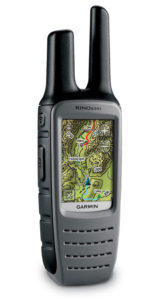
The General Mobile Radio Service (GMRS) requires one adult, who is the head of the household, to obtain an FCC license. The license covers your immediate family, and gives you access to local- or intermediate-range communications between family members. Some handheld GMRS radios claim up to a 36-mile range, but most GMRS units are handheld “walkie-talkie” style and are limited to 5 watts, making them much shorter distance options. While the actual power limit is 50 watts for this service, there is a loosely-scattered network of GMRS repeaters around the country (a repeater is a high powered station that receives weak signals and retransmits the signal on a different frequency at high power to cover a much greater distance) so if you need to stay in contact with family located over a few miles a way (but less than 50) GMRS may work for you.
Similar to the GMRS, the Family Radio Service, or FRS, is intended to keep, as its namesake implies, family members in contact with one another. You do not need a license to operate a radio in this service. However, FRS is considered a close-range proposition, due to the fact that radios are limited to one-half watt. In practical terms, FRS radio is a one-mile or less choice. One thing to note: Many FRS radios have GMRS capability, so be sure not to operate the radio outside of the FRS limits unless you have the GMRS license. That being said, one principle of preparedness is using gear that covers more than one use. Thus, one of the handiest units I’ve seen in this category is the Garmin Rino — a GMRS/FRS radio with full Garmin GPS capability. Not only do you get two radio services covered with one transceiver, but you can find your way to safety (assuming the satellites are working).
Two final, less popular options are the Low Power Radio Service (LPRS) and Multi-Use Radio Service (MURS). The former uses one-way radio to transmit voice or data information to disabled persons. The latter, MURS, is a two-way service with five allocated channels in the VHF band. Radios used for this service are limited to 2 watts; a license is not required.
There’s only one thing you can absolutely count on when it comes to your cell phone: It will fail — probably when you need it the most. However, long-range communication is still possible if you plan now to incorporate two-way radio into your family preparedness plan. Sometimes, your ability to get a signal out is your only lifeline to outside help. Don’t entrust your family’s safety to a telecomm company’s flimsy cell phone network. Instead, get an emergency radio now and get on the air, while you still can — and stay on the air, when all else fails.
With more and more ammunition makers are going to lead-free bullets, one crime scene investigator is worried that the lack of lead may compromise criminal investigations.
“This [move toward lead-free bullets] is a potential game changer,” Michael Knox, a seasoned crime scene investigator based in Jacksonville, Florida, told WKMG TV Orlando.

“Right now, investigators can reconstruct most gun crime scenes because they know how lead bullets perform in every conceivable situation,” WKMG reported. “The science is foolproof and accepted in every court. Knox said investigators have no idea how lead-free bullets will react when fired. There is little acceptable science because lead-free bullets are so new; certainly nothing any court would rule admissible-yet.”
“We have to have some idea of what we're looking for [during a criminal investigation],” said Knox. “Or we could miss [evidence that would point to a shooter] all together.”
It gets worse. Another researcher, Dr. Michael Sigman, of the National Center for Forensic Science, “and his team are analyzing the already known lead-free bullets available to determine what they're made of. They have already made one vital discovery. Ammunition makers are not replacing lead with another universal material.”
“Each manufacturer is using their own combination of metals or materials or alloys for that particular bullet,” said Knox. “And they're not sharing that information. It's proprietary information, like how Coca-Cola doesn't share its recipe for its beverages.”
This isn't the first time lead-free ammunition has been called into question by authorities. Research in 2011 on tungsten bullets concluded that the lead-free bullets may harm mammal immune systems. Per the report:
Laboratory mice given drinking water containing small amounts of a tungsten compound were examined to see where in their bodies the tungsten ended up. Researchers found the highest concentrations of tungsten were found in the spleen, one of the main components of the immune system, and in bone marrow, the initial source of all the cells of the immune system.
As such, the jury is still out on a universal replacement for lead-free bullets.
 The Gun Digest Book of Green Shooting is a go-to source of information on lead-free bullets. Author Rick Sapp reviews the latest lead-free bullets and explains their benefits to the shooter and reloader. Sapp also covers a range of modifications needed to take full advantage of lead-free bullets' performance.
The Gun Digest Book of Green Shooting is a go-to source of information on lead-free bullets. Author Rick Sapp reviews the latest lead-free bullets and explains their benefits to the shooter and reloader. Sapp also covers a range of modifications needed to take full advantage of lead-free bullets' performance.
Click here to order the Gun Digest Book of Green Shooting from GunDigestStore.com and save 35% off retail.

Editor's Note: Following a disaster, access to friends and family may be not be as easy as opening a door. Understanding dynamic entry tools and techniques is important. Tactical expert and law enforcement veteran Dave Morelli explains these concepts in this article.
When we think about dynamic entry, which could involve breaching a door or other obstacle, the SWAT operator immediately comes to mind. That’s because, normally the dynamic entry tools needed for breaching a door are not found in the patrol car.

Depending on the department’s policy on handling an emergency entry situation the patrolman might come upon a call where he has the justification of breaching a door to gain entry and need to do it right now, not when SWAT arrives.
I responded to a call one evening to a large tower hotel that security reported a woman screaming for help from one of the rooms. The room was not in the tower but on the second floor of an outside-accessible complex. The doors were steel and the railing was only about 4 feet from the door, making it hard to get a good position for a kick, especially on a steel door.
Security reported that the door was locked with a dead bolt from the inside and could not be opened with a key. We could hear the woman being thrown around and the guy’s response to our verbal commands was that it was a “private matter” and we should go away or he would come out and kick our butts. Well, if he would have come out to do it the problem would have been solved, but he didn’t and continued beating the woman. We decided some sort of entry was necessary and it needed to be immediate.
I asked the security guard if he could get someone from maintenance to bring up a sledge hammer with which we could breecht he door. We continued talking to the guy while security was getting our request. A few minutes later a guy showed up with a huge 3-foot-long pipe wrench that felt like it weighed 50pounds. It was so big I couldn’t get it on the knob and make a twist to break the lock.
So with the woman screaming I revved up the huge wrench and landed a blow just above the knob on the door. It flew open hard and a naked lady with a swollen face and bruises all over her greeted us. There was also a half-naked guy lying on the floor with the tweety birds flying around his head. According to the lady just before we made entry he put his head to the door in attempt to hear what we were doing.
Bad move! Fortunately he was not seriously hurt and it actually improved his attitude, as he was cooperative when he came to. (Knocked some sense into him I guess.)

I think about that call now and then, because part of the situation really was kind of funny. But I also think about how many fewer blows the lady would have had to endure if I had some sort of breaching tools in the patrol car, or at least one of the cars in the area. Come to think of it there were a lot of calls we responded to where some dynamic entry tools would have made life easier.

Back then BLACKHAWK! was just starting out, selling mostly packs and nylon stuff. Today they sell a variety of breaching tools along with other necessities for police, fire and rescue folks to fit just about every occasion. From a SWAT call to fire and rescue, to the individual patrolman on a small department with the need for some breaching tools, BLACKHAWK! has something for everyone. There are rams, pry tools, window rakes and bolt cutters. They even have collapsible products that are lighter and take up less space when stored in the vehicle.
Any burglar will tell you there aren’t many doors that will withstand a well-placed shot from a 3- to 5-pound sledge hammer or even a modest sized pair of channel locks. The problem with the channel locks is you have to stand in front of the door to get any leverage. (Fatal Funnel Syndrome.) A long-handled sledge can be manipulated from well along side the door and opens the door quickly for fast entry.
One of BLACKHAWK!’s entry kits, The Dynamic Duo, has a long-handled sledge and The Breacher, which is a pry type tool with 3 feet of prying torque. The head on the Breacher is a tempered stainless steel wedge that has friction ridges on all contact surfaces that counter angled to the head. This improves stability and reduces slippage during use. The Duo comes in a kit holster made from nylon.
BLACKHAWK! also makes a variety of hallagan tools in many configurations that will get the pry on just about any door. They come in mini tool kits and non-sparking non conductive metals for use when there if fear of fire or explosion. They even carry them in stainless steel. There are even tools specific to mobile home doors which usually open outward. But when it comes right down to it, the most useful and versatile is the ram.
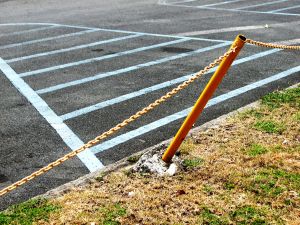
September 1, 2012 was the one-year anniversary of Senate Bill 321 taking effect in Texas. Supported by the National Rifle Association (NRA), SB 321 was an employee parking lot gun law, signed into law by Governor Rick Perry in June of 2011.
In a nutshell, the law prohibits employers from banning storage of firearms in employee vehicles parked in company lots.
Recently, NRA asked Texas gun owners to be on the lookout for employers not following this parking lot gun law. As an NRA press release noted, “We have already received information about companies that are misinterpreting the [parking lot gun law] or ignoring it altogether.”
“In order to comply with this [parking lot gun law]'s provisions, most employers in the state have amended their policies to allow the transportation and storage of firearms in locked, employee-owned motor vehicles parked on company-controlled parking lots. However, the NRA needs your help to ensure that no hard-working, law-abiding Texans remain disenfranchised by employers who refuse to abide by this [parking lot gun law]. Please notify the NRA-ILA by email of any examples of company policies that continue to violate the spirit and intent of the statute, and any instances of employees being disciplined or terminated under such policies.”
Of note, SB 321 did not authorize an employee to possess firearms on any property where such possession was prohibited by state or federal law. In addition, the provisions of the parking lot gun law did not apply to vehicles owned or leased by the employer and used by the employee for work purposes.
Gun Digest is the source for firearms news, pricing and guns for sale. With a subscription to Gun Digest, readers benefit from in-depth editorial expert advice, show reviews, how-to instructions and Second Amendment issues.
* Deer Hunting Gear Round-Up
* Castle Doctrine and Stand Your Ground
* Zombie Shooting
* Field Gun Review: Pedersoli SxS Blackpowder
* A Gathering of Gunsmiths
* Precision Marksmanship: Getting Started in Long-Range Shooting
* Performance Handloading: BL-C(2), Time-Tested Powder
* Know Your Cartridge: The 6.5 Creedmoor
Click here to start a subscription to Gun Digest.
Did you receive a suspicious subscription offer? A bogus company is sending out Gun Digest subscription scams.

The Fargo-Moorhead area of northwest Minnesota was hit hard this week by something no one expected in early October: 14 inches of snow. It caught residents completely by surprise. Few had winter survival kits in their cars, putting many stranded motorists at risk. Homes were just as unprepared, as power went out across the region.
No one died, but the possibility certainly wasn't out of the question. It's time to start thinking about how to survive a blizzard.
The National Oceanic and Atmospheric Administration (NOAA) has some great tips for preppers, including how to survive a blizzard. With winter storms just around the corner for the rest of the country, it's never been a better time to review.
Here are the NOAA's recommendations, as condensed by Gun Digest.
Being outside during a blizzard can be lethal. It's not the cold so much as the disorientation. High winds and heavy snow reduce visibility, which increases the chance of becoming lost. That when things get deadly.
If Shelter is Available
* Stay dry
* Cover all exposed body parts
* Determine if there is some way to make the shelter visible to others
If Shelter is Not Available
* Build a lean-to, windbreak or snow cave for wind protection
* Make a fire for heat and to attract attention (this might be impossible, but the takeaway is that warmth will prevent hypothermia)
* If a fire is created, place rocks or other heat conductors around it to absorb and reflect warmth
* Melt snow for water
* Don't eat snow, it lowers body temperature and invites hypothermia
* Find a way to attract attention to initiate a rescue
* Stay in the vehicle, as it provides shelter and an easy way to be spotted by help
* Run the engine for about 10 minutes each hour for warmth
* Open the window a crack to keep air circulating in order prevent carbon monoxide poisoning
* Clear the exhaust pipe of any obstruction to keep fumes from entering the cab
* Move arms, legs, fingers and toes vigorously from time to time for warmth
Tips for Attracting Attention
* Turn on interior or exterior lights while the engine is running
* Honk the horn if help is close
* Tie a piece of cloth (eye-catching colors work best) to the antenna
* Once the snow stops, raise the hood to signal help is needed
Houses offer a false sense of security during blizzards. Heavy snow and harsh winds can knock out power, shutting down heating systems. Structures may collapse. Ice may cement doors closed. Help could be hours or days away. Travel can be impossible.
* When using heat sources that require ventilation (a fireplace, for example), make sure snow and ice is not preventing proper exhaust
* Close off unused spaces to focus heat in used areas
* Close cracks in doors and windows with towels or rags
* Wear layers of loose-fitting, lightweight clothing, and remove them if perspiration kicks in
No matter the situation, there's one golden rule to hold above everything else: Avoid overexertion.
From the NOAA:
“The strain from the cold and the hard labor may cause a heart attack. Sweating could lead to a chill and hypothermia. Take Red Cross Cardiopulminary Rescue (CPR) and Automated External Defi brillator (AED) training so you can respond quickly to an emergency.”
For about how to survive a blizzard, check out Gun Digest‘s articles about making a winter car survival kit and a winter bug-out bag.
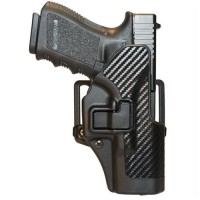
A group of 26 real estate agents from the Waco Association of Realtors recently took the 10-hour concealed carry class needed to qualify for a Texas concealed handgun license (CHL).
“The group decided to take the class together this month to observe Realtor Safety Month, as declared by the National Association of Realtors,” said Tara DeLeon, executive assistant at the Waco Association of Realtors, as reported by the Waco Tribune. “All in the group passed the course, and many said they will be packing heat while pointing out the finer points of homes for sale.”
“I definitely will be carrying [a concealed handgun],” said Donna Sharp, an agent with Premiere Realty. “I would suggest anyone in a service profession like this to take this course. Things happen, and you never know when it could happen to you.”
As the Tribune noted, being a real estate agent can be quite risky. They meet complete strangers, often at empty houses, at various times of the day and night. In other cities, agents have been targeted by criminals for robbery and worse.
Parnell McNamara taught the concealed carry class to the Waco agents.
According to the Tribune, McNamara said he has taught concealed carry classes that feature members of the same profession, including a number of bank employees and one class with nine ministers. But the real estate association was the largest group he has taught from one profession.
“Real estate agents are very vulnerable,” McNamara said. “I think it is great that they want to learn how to protect themselves.”
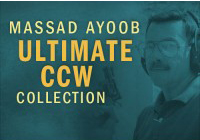 Learn from concealed carry expert Massad Ayoob at your own pace with Gun Digest's Massad Ayoob Ultimate CCW Collection. It contains five books, a magazine, a DVD and an online video, all focused on concealed carry.
Learn from concealed carry expert Massad Ayoob at your own pace with Gun Digest's Massad Ayoob Ultimate CCW Collection. It contains five books, a magazine, a DVD and an online video, all focused on concealed carry.
Click here to get this incredible concealed carry class package for just $79.99 (that's $130.39 off retail).
Metal mint boxes are a great way to keep a survival kit handy. They close securely, resist the elements and are the perfect pocket size.
In this video from Columbia River Knife & Tool (CRKT), Doug Ritter explains how to build a survival kit inside one. He incorporates one of his designs, the CRKT Ritter Survival Knife.
Here's a rundown of the kit in the video:
* Small metal box (similar to ones sold with mints inside)
* CRKT Ritter Survival Knife (click here to see a video review of the knife from Ritter)
Knife Specs:
Weighs less than 1 ounce
1.75″ wide-chord drop-point blade
High-carbon steel
Stonewashed finish for corrosion resistance
Ergonomic handle
Nylon cord adds length, grip
Includes custom-fitted Zytel sheath
Comes with the metal box shown in the video
* Aluminum foil
* Waterproof note paper
* Pencil
* Signaling mirror
* Duct tape
* Whistle
* Firestarting tool
* Tinder
* Needle
* Fishing hooks
* Fishing sinkers
* Heavy duty nylon thread
* Safety pins
* 170-pound test line
* Wire
* Compass
* Flashlight
That's quite a bit for just one small, metal box. Best of all, this survival kit is highly portable and affordable. Leave one in the car, at the office, in an ATV, in the pouch of a hunting stand or anywhere survival is a must.
Talk more about survival knives on KnifeForums.com.
 GunDigestStore.com has the CRKT Ritter Survival Knife at 28% off retail. That's just $21.59 for a small yet effective survival tool.
GunDigestStore.com has the CRKT Ritter Survival Knife at 28% off retail. That's just $21.59 for a small yet effective survival tool.
Click here to order the CRKT Ritter Survival Knife. The page includes a video of Ritter explaining more on how to use it.

How you handle the effects of the situation brought on by panic can determine your rate of success or failure in any outdoors-emergency situation.
To emphasize the effect that panic can have on an individual, let me use the principle of the “RULES OF 3”. Experience has shown that:
You can only expect to survive in a panic induced emergency situation for only about “3 seconds”,
You can only expect to survive without oxygen or from severe bleeding for up to “3 minutes”,
You can only expect to survive exposure to excesses of heat or frigid cold for up to “3 hours” and,
You can only expect to survive without any major intake of food and water for up to “3 days”.
Panic, as you can see is your major enemy. Panic is the one thing you must overcome, at once, because panic can cause you great harm.
To help you deal with the onset of panic lets look at a simple method of handling an emergency situation. Remember the acronym S.T.O.P. It stands for Sit, Think, Observe, Plan.
When you realize that you are lost or disoriented. Take the time to sit down and collect your thoughts. You are not lost, you are right where you are, your camp, vehicle and everyone else is just not where you thought they were.
What do I have at my disposal? Take an inventory of physical supplies and mental that will help me cope with this situation. Take an inventory of your survival kit items and how you will use them, if needed. Take an inventory of your skills within your mind, remember what you always thought you would do if you got lost or stranded. Most of all you must maintain a positive mental attitude; you will survive.
Look around, is there shelter, water, high ground, and an open area so the searchers can see you. It will be easier for those searching to find you if you can stay in one selected location that will allow you to build a fire, provide shelter, set out signals and be in an area that can be seen at a distance or from aircraft.
Now create your plan of action. Be positive and take care of yourself. If it is late in the day, build a fire for heat and signaling, find or make a shelter against the weather, and most of all remain positive, you do have the ability to survive. You have conquered the major danger of not allowing panic to cast your fate; you can now conquer anything else that confronts you.
As human beings we all have deep within us the necessary skills to survive when lost or stranded. What dampens these skills is the onset of panic. If you can keep yourself from allowing panic to rule, YOU WILL SURVIVE.
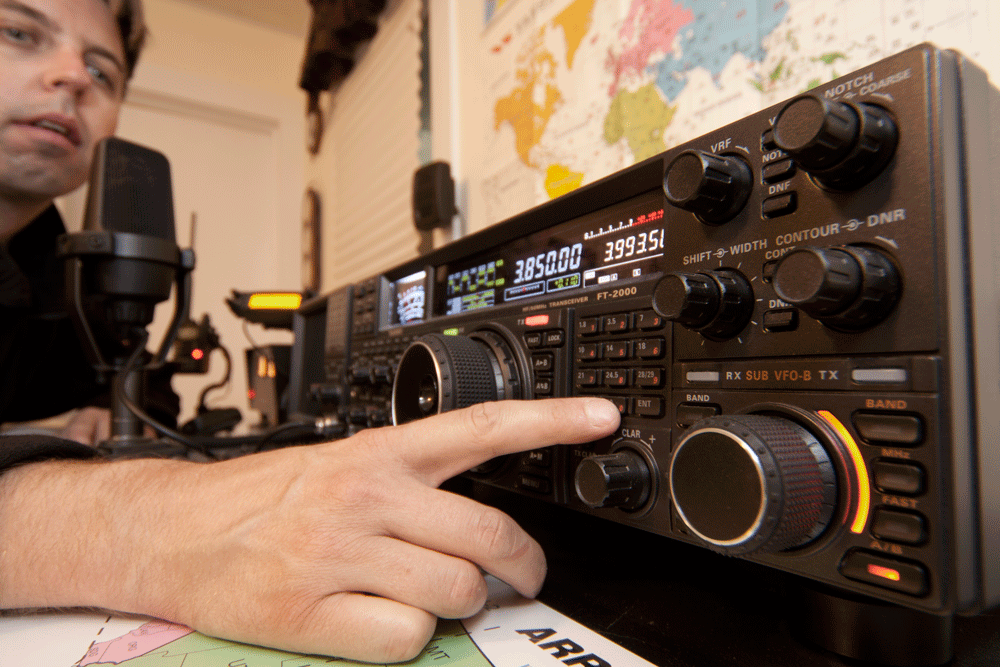
Editor's Note: This is the second of a 3-part series looking at two-way emergency radio for disaster preparedness. Click here to read part I. Click here to read Part 3.
The advantage of radio lies in its ability to send and receive a signal, with no help from others. Two-way radio has come a long way since the early days of Guglielmo Marconi’s historic transatlantic wireless transmission that must have struck people in those days as nothing short of magic.
Today, two-way radio transceivers (transmitter-receivers) are as technologically advanced as any other “tech gadget” — with amateur or ham radio leading the march toward integration with the Internet, GPS and exotic new data modes. But at its most basic level, radio is still radio. Like the basic Marconi set that transmitted the distress signal from the sinking Titanic, it works today for the same reason it worked then: It relies on no one else to get a message out. Thus it remains the best, most reliable form of communication for emergencies.
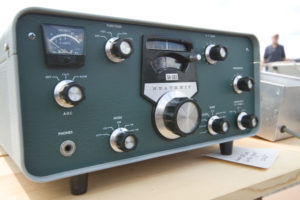
Wireless two-way allows you to be a locally operated independent radio station. You are the network, in essence, and can take advantage of built-in network redundancy, communicating with other independent operators. If one operator loses capability, the network keeps chugging along. There is no middleman. And, other than initial equipment purchase and license fees, there is no cost, either.
Not so with commercial telecommunications systems. By their very nature, commercial communications are centralized. That means that all calls go through your service provider’s network.
If that system gets overloaded, which it will in the event of a widespread disaster, you’re out. These systems are designed to make private companies money, not to ensure you can communicate during times of uncertainty. So fickle are they that any event that gets people talking can spark telecomm gridlock.
Equally troublesome is the weather: An ice storm or a wind event such as tornado or straight-line winds can twist lines into high voltage pretzels — rendering your smartphone into nothing more than a fancy-looking paperweight.
Gun Digest is the source for firearms news, pricing and guns for sale. With a subscription to Gun Digest, readers benefit from in-depth editorial expert advice, show reviews, how-to instructions and Second Amendment issues.
Click here to download this issue as a PDF from GunDigestStore.com.
Inside This Issue
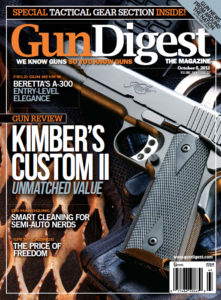 * Kimber Custom II: A high-value handgun worth the investment
* Kimber Custom II: A high-value handgun worth the investment
* The truth about gun tests
* Special tactical gear section
* A conspiracy theory debunked
* Know Your Cartridge: The .416 Rigby
* Field Gun Review: Beretta A300
* On Handguns: Smart cleaning semi-autos
* Spent Casings: The price of freedom
* Collector's Corner: Broomhandle Mauser
* Trends of Value: Remington rifles, T. Reuth shotguns and Jacob Rupertus handguns
Click here to start a subscription to Gun Digest.
Did you receive a suspicious subscription offer? A bogus company is sending out Gun Digest subscription scams.
Courtesy of the National Shooting Sports Foundation (NSSF), Gunsite Instructor Cory Trapp goes through AR-15 disassembly, cleaning, maintenance and inspection.
This is one of the better videos I've seen on this subject, especially how Trapp dispells several AR-15 myths related to lubrication and reliability.
He covers: